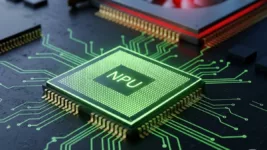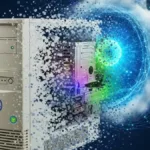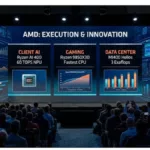The landscape of artificial intelligence (AI) hardware, long dominated by the formidable Graphics Processing Units (GPUs) championed by NVIDIA, is on the cusp of a significant transformation. A recent breakthrough from the Korea Advanced Institute of Science and Technology (KAIST) signals a potent new challenger: an energy-efficient Neural Processing Unit (NPU) core technology designed specifically for generative AI models. This development, accepted by the prestigious 2025 International Symposium on Computer Architecture (ISCA 2025), is not merely an incremental improvement; it represents a fundamental shift that could reshape the competitive dynamics of the AI industry, posing a direct challenge to NVIDIA’s entrenched leadership.
NVIDIA’s GPU Stronghold and Emerging Exposure
For years, NVIDIA has been the undisputed king of AI hardware, primarily due to the unparalleled parallel processing capabilities of its GPUs. These powerful chips have become the de facto standard for training and deploying complex AI models, particularly large language models (LLMs) like OpenAI’s ChatGPT-4 and Google’s Gemini 2.5, which demand immense memory bandwidth and capacity. Companies building generative AI clouds, such as Microsoft and Google, have invested hundreds of thousands of NVIDIA GPUs to power their operations as reported by KAIST. NVIDIA’s robust CUDA software ecosystem has further solidified its position, making its GPUs the go-to choice for AI practitioners.
However, NVIDIA’s dominance, while impressive, has largely been built around general-purpose GPUs. While highly versatile and powerful for both AI training and inference, GPUs are also known for being large, expensive and energy-intensive as highlighted by InsideAI News. This is where the emergence of specialized NPUs, like the one from KAIST, presents a significant point of exposure for NVIDIA. NPUs are purpose-built for AI workloads, specifically neural network computations, and their design prioritizes efficiency for AI inference tasks as detailed by Collabnix and Wevolver. NVIDIA’s current strategy has not fully embraced this specialized NPU technology for inference at scale, leaving a potential opening for more optimized, lower-power solutions to gain traction, particularly in areas where energy consumption and cost are critical factors.
Technical Superiority: NPU vs. GPU for Inference
The KAIST research team, in collaboration with HyperAccel Inc., has developed an NPU core technology that dramatically improves the inference performance of generative AI models by an average of over 60% while consuming approximately 44% less power compared to the latest GPUs, a breakthrough announced by KAIST News Center and ChosunBiz. This significant performance leap for inference is a direct result of the NPU’s specialized architecture.
Unlike GPUs, which are designed for a broad range of parallel processing tasks including graphics rendering, NPUs are meticulously optimized for the repetitive, matrix multiplication operations inherent in neural networks, as explained by IBM and Pure Storage. Key technical advantages include:
- High-speed On-chip Memory: NPUs feature integrated high-speed memory, allowing rapid access to model data and weights, minimizing memory bottlenecks that can plague GPUs during inference, a key advantage noted by IBM and Micro Center.
- Specialized Architecture: Their design mimics the human brain’s data processing, with modules specifically accelerating multiplication and addition operations crucial for AI workloads, as described by IBM.
- Superior Power Efficiency: NPUs are inherently more power-efficient than GPUs for AI tasks, making them ideal for scenarios where energy consumption is a major concern, such as edge devices, mobile applications and large-scale AI cloud data centers, according to Collabnix and Micro Center.
- Lower Latency for Real-time AI: Their optimized architecture allows for faster, real-time AI tasks like voice recognition, facial recognition and autonomous driving where quick responses are critical as detailed by Wevolver and IBM.
While GPUs still excel in large-scale AI model training due to their sheer computational power and versatility, NPUs are proving to be superior for inference, which is the process of using a trained AI model to make predictions or decisions. As AI models become more ubiquitous and deployed across countless devices and services, efficient inference becomes paramount.
The Broader Landscape: Other Emerging AI Hardware
The KAIST NPU is not an isolated development; it is part of a broader trend of specialized AI hardware accelerators emerging to challenge the GPU’s reign. Several companies and research institutions are developing alternative architectures optimized for various AI workloads:
- Google’s Tensor Processing Units (TPUs): Google has been a pioneer in custom AI chips with its TPUs, designed specifically for TensorFlow workloads in its data centers.
- Intel’s Gaudi Accelerators: Intel has been actively developing its Gaudi NPUs, which aim to compete directly with NVIDIA’s GPUs in the AI server market, showing competitive performance in some AI workloads as evaluated in an arXiv paper.
- Graphcore’s IPUs (Intelligence Processing Units): Graphcore focuses on IPUs, designed from the ground up for machine learning.
- Cerebras Systems’ Wafer Scale Engine (WSE): Cerebras offers massive, single-wafer chips for extreme AI training workloads.
- Edge AI Accelerators: Companies like Hailo (Hailo-8), Qualcomm (Robotics RB5), and Intel (Neural Compute Stick 2) are developing highly efficient NPUs and VPUs (Vision Processing Units) for on-device AI in smartphones, IoT devices and autonomous systems as listed by Jaycon.
- Photonic Processors: Emerging companies like Lightmatter are exploring optical computing, leveraging light for AI computations, promising even greater energy efficiency in the long term according to industry analysis.
These diverse technologies, each with its own strengths and target applications, collectively put NVIDIA’s leadership at additional risk. While NVIDIA’s ecosystem and established position are formidable, the increasing specialization and efficiency of these alternative architectures could fragment the AI hardware market, forcing NVIDIA to adapt or potentially lose market share in specific segments, particularly in the rapidly growing inference space.
Energy Efficiency: The AI Imperative
The emphasis on energy efficiency in the KAIST NPU is not merely a technical nicety; it is a critical imperative for the sustainable growth and widespread adoption of AI. AI, especially large language models, consumes enormous computational resources. Training these models can involve thousands of GPUs running continuously for months, leading to staggering electricity consumption, a concern highlighted by Penn State’s IEE. Projections suggest that by 2030–2035, data centers could account for 20% of global electricity use, placing immense strain on power grids and raising significant environmental concerns as reported by Penn State’s IEE.
Lower energy consumption directly translates to reduced operational costs for AI cloud providers and extended battery life for edge devices, a point emphasized by Forbes. As AI permeates every aspect of daily life, from smart homes to autonomous vehicles, the ability to perform complex AI tasks with minimal power will be a key differentiator. Energy-efficient hardware like the KAIST NPU addresses these concerns head-on, making AI deployments more sustainable, cost-effective and viable for a broader range of applications, including those with limited power resources or strict environmental mandates.
Market Entry and Mitigation Strategies for NVIDIA
While the KAIST NPU technology has been accepted for presentation at ISCA 2025, its journey from research breakthrough to widespread commercial market adoption will take time. Typically, such core technologies require further development, prototyping and mass production capabilities. However, the rapid pace of generative AI adoption, which has outstripped even the internet and smartphones in its initial growth as detailed by Semiconductor Engineering, suggests that the demand for efficient AI hardware will accelerate its market entry. We can expect to see such energy-efficient NPUs begin to make a noticeable impact in specialized inference applications and edge devices within the next two to five years, with broader adoption in data centers potentially following.
For existing AI hardware companies like NVIDIA, mitigating this competitive risk requires a multi-pronged approach:
- Embrace Hybrid Architectures: Instead of solely relying on general-purpose GPUs, NVIDIA should accelerate its development and integration of specialized NPU cores within its existing GPU architectures, creating hybrid chips optimized for both training and inference. This would allow them to leverage their GPU strengths while addressing the NPU’s efficiency advantages.
- Expand Software Ecosystem for Inference: While CUDA is powerful for training, NVIDIA needs to ensure its software stack is equally optimized for efficient NPU-like inference, potentially through new libraries or frameworks that simplify NPU programming.
- Strategic Acquisitions and Partnerships: NVIDIA could acquire promising NPU startups or form strategic partnerships with companies developing cutting-edge NPU technologies to quickly integrate their innovations.
- Focus on “AI Transformation (AX)”: As highlighted by KAIST, the NPU is expected to play a key role in the “AI transformation” environment, particularly for dynamic, executable AI. NVIDIA should actively invest in solutions that cater to this growing segment, offering integrated hardware-software platforms that simplify AI deployment at the edge and in specialized cloud environments.
- Cost and Power Optimization: Continuously push the boundaries of energy efficiency and cost reduction in their GPU designs, even as they develop NPU-like capabilities.
Wrapping Up
The KAIST NPU development is a clear signal that the AI hardware market is evolving beyond a singular focus on raw computational power. The emphasis on energy efficiency and specialized inference capabilities represents a significant threat to NVIDIA’s unchallenged dominance, particularly as AI permeates more power-constrained and cost-sensitive environments. While NVIDIA’s position remains strong, the emergence of highly efficient NPUs and other specialized accelerators necessitates a proactive and adaptive strategy. The future of AI hardware will likely be a diverse ecosystem where optimized, energy-efficient solutions play an increasingly critical role, forcing even the giants to innovate or risk being outmaneuvered.








